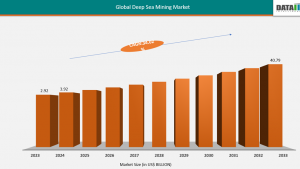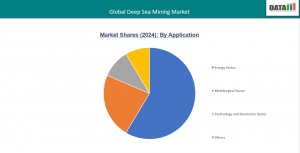Deep-Sea Mining Market Sector to hit $40.79B by 2032, Growing at 34% CAGR from 2025 to 2032
Deep-Sea Mining Market: Navigating the Depths of Opportunity and Responsibility
Deep-Sea Mining Market in the USA valued at $3.92B in 2024, projected to reach $40.79B by 2032, growing at 34% CAGR”
WASHINGTON, MA, UNITED STATES, October 6, 2025 /EINPresswire.com/ -- Deep-Sea Mining Market Overview— DataM Intelligence 4Market Research LLP
The deep-sea mining industry is undergoing a transformative phase, driven by the escalating demand for critical minerals essential for technologies such as electric vehicles, renewable energy systems, and advanced electronics. As terrestrial resources become increasingly scarce, the deep ocean floor rich in polymetallic nodules, cobalt-rich ferromanganese crusts, and seafloor massive sulfides has emerged as a potential frontier for resource extraction. However, this pursuit is not without its challenges, particularly concerning environmental sustainability and regulatory frameworks.
Market Size and Forecast
The global deep-sea mining market was valued at approximately US$3.92 billion in 2024 and is projected to reach US$40.79 billion by 2032, reflecting a compound annual growth rate (CAGR) of 34.02% from 2025 to 2032
The deep-sea mining market is poised for significant growth, driven by the increasing demand for critical minerals and technological advancements. However, the industry must navigate environmental challenges and regulatory complexities to ensure sustainable development.
Market Size and Forecast
2024 Market Size: US$ 3.92 Billion
2032 Projected Market Size: US$ 40.79 billion
CAGR (2025-2032): 34.02%
Largest Market: Asia-Pacific
Fastest Market: North America
Get a Sample PDF Of This Report (Get Higher Priority for Corporate Email ID):– https://www.datamintelligence.com/download-sample/deep-sea-mining-market
Trends and Latest Insights
Asia-Pacific leads the global Deep-Sea Mining Market with a 36.23% revenue share in 2024.
The metallurgical sector holds the largest share among end-users in the global Deep-Sea Mining Market.
In 2023, the IMO set a 40% emission cut by 2030 and net-zero by 2050. Rising clean energy adoption boosts demand for nickel, cobalt, and copper, making deep-sea mining a key supply source.
Key Drivers of Market Growth
Rising Demand for Critical Minerals: The transition to renewable energy sources and the proliferation of electric vehicles have significantly increased the demand for minerals like cobalt, nickel, and rare earth elements. These materials are integral to the production of batteries, solar panels, and wind turbines.
Technological Advancements: Innovations in robotics, artificial intelligence, and sustainable extraction techniques are enhancing the efficiency and safety of deep-sea mining operations. These advancements are crucial for operating in the challenging and remote deep-sea environment.
Geopolitical Factors: Nations are seeking to reduce their dependency on foreign sources for critical minerals. This drive for mineral independence is prompting countries to explore domestic offshore mining opportunities.
Key Players
1. Adepth Minerals AS
2. Cook Islands Investment Corporation (Cobalt Seabed Resources)
3. China Ocean Mineral Resources R&D Association
4. Kawasaki Heavy Industries, Ltd.
5. Eramet
6. Impossible Metals Inc
7. Nautilus Mineral
8. Neptune Minerals Inc.
9. Moana Minerals
10. Global Sea Mineral Resources
Get Customization in the report as per your requirements:- https://www.datamintelligence.com/customize/deep-sea-mining-market
Key industry Developments
In 2025, The Metal Company (TMC) submitted the first U.S. commercial seabed mining permit, supported by an $85.2 million strategic investment from Korea Zinc. This partnership aims to advance deep-sea mining by enabling nodule processing for battery metals, boosting U.S.-based refining capabilities, and reducing reliance on Chinese supply chains.
Similarly, in 2025, Cobalt Seabed Resources (CSR) progressed with deep-sea exploration in the Cook Islands, focusing on seabed nodules rich in cobalt, nickel, and copper. These metals play a critical role in metallurgical applications such as alloy production, steelmaking, and non-ferrous refining. By accessing high-density deposits, CSR strengthens the industry’s ability to secure long-term mineral supplies amid rising global demand.
Additionally, in 2025, Bahrain supported Impossible Metals in applying for an ISA exploration license in the Clarion Clipperton Zone. The initiative targets seabed nodules abundant in cobalt, nickel, and copper essential minerals for clean energy technologies and metallurgical refining.
Environmental Considerations
While the economic incentives are compelling, deep-sea mining raises significant environmental concerns:
Ecosystem Disruption: Mining activities can lead to the destruction of unique deep-sea habitats, affecting biodiversity and disrupting marine ecosystems.
Pollution: The extraction process may release toxic substances into the water column, potentially impacting marine life and water quality.
Sediment Plumes: Disturbance of the seabed can create sediment plumes that smother marine organisms and affect the health of coral reefs.
Regulatory Landscape
The regulatory environment for deep-sea mining is complex and varies by region:
International Regulations: The International Seabed Authority (ISA) oversees mineral-related activities in international waters, aiming to ensure that these activities are conducted responsibly and equitably.
National Policies: Countries like Canada are developing frameworks to govern offshore mining activities, balancing economic interests with environmental protection.
Technological Innovations
Advancements in technology are pivotal to the future of deep-sea mining:
Robotic Systems: Autonomous underwater vehicles (AUVs) and remotely operated vehicles (ROVs) are being developed to perform precise and efficient mining operations at great depths.
Sustainable Practices: Research into environmentally friendly mining techniques is ongoing, focusing on minimizing ecological footprints and enhancing the sustainability of operations.
Regional Trends
Asia-Pacific Leads Deep-Sea Mining
The Asia-Pacific region dominates the global deep-sea mining market, driven by demand for cobalt, nickel, and copper. Countries like China, India, Japan, and South Korea are investing in seabed exploration across the Pacific and Indian Oceans, focusing on polymetallic nodules, cobalt-rich crusts, and seafloor sulphides to support renewable energy, electronics, and industrial growth.
China
China leads with strong government backing, multiple International Seabed Authority (ISA) licenses, and state-owned enterprises targeting cobalt, nickel, and copper. By 2025, it emerged as the top player, securing minerals vital for batteries, clean energy, and industrial expansion.
India
India is expanding through initiatives like the Deep Ocean Mission, backed by ISA contracts and government grants. In 2025, it obtained 15-year exploration rights, focusing on polymetallic nodules and sulphides to strengthen clean energy and manufacturing supply chains.
North America
North America’s deep-sea mining sector grows with rising demand for critical minerals for EVs, electronics, and renewable energy. Advanced technologies, R&D capabilities, and a push for mineral independence support regional growth.
U.S.: The Department of the Interior introduced new rules in 2025 to accelerate seabed mining, targeting polymetallic nodules and cobalt-rich crusts.
Canada: Leveraging maritime resources and strong regulations, Canadian firms like The Metals Company pursue exploration licenses and commercial recovery permits, aiming to support the clean energy transition.
Market Segments
By Resource Type: Polymetallic Nodules, Polymetallic Sulphides, Cobalt-rich Ferromanganese Crusts, Others
By Technology: Remote Operated Vehicles, Autonomous Underwater Vehicles, Seafloor Mining Systems, Exploration, Extraction & Collection, Others
By End-User: Energy Sector, Metallurgical Sector, Technology and Electronics Sector, Construction Sector, Aerospace sector
Buy Now & Unlock 360° Market Intelligence:- https://www.datamintelligence.com/buy-now-page?report=deep-sea-mining-market
Conclusion
Deep-sea mining presents a promising avenue for meeting the growing demand for critical minerals. Nevertheless, it is imperative that the industry proceeds with caution, implementing stringent environmental safeguards and adhering to robust regulatory frameworks. By balancing economic objectives with environmental stewardship, deep-sea mining can contribute to the sustainable development of global mineral resources.
Related Reports
Mining Explosive Market
Iron Ore Mining Market
Sai Kumar
DataM Intelligence 4Market Research LLP
+1 877-441-4866
sai.k@datamintelligence.com
Visit us on social media:
LinkedIn
X
Legal Disclaimer:
EIN Presswire provides this news content "as is" without warranty of any kind. We do not accept any responsibility or liability for the accuracy, content, images, videos, licenses, completeness, legality, or reliability of the information contained in this article. If you have any complaints or copyright issues related to this article, kindly contact the author above.


